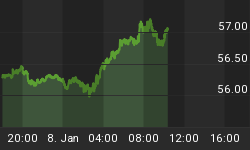Reader Erik asks a good question regarding investor sentiment. In particular, he wanted to know how bullish investors became during bear market rallies during 2008 and 2009. We will do our good reader one better, and look at the behavior of the sentiment indicator during the 2001 to 2002 bear market as well.
Before getting to specifics, let me first address several things about investor sentiment. It is my belief that most market participants look at investor sentiment as giving them some information about when a market will change direction because there are too many buyers or sellers on one side of a trend. In other words, if we can only determine when there are too many investors on one side of a trade then we could capitalize on that information by betting against the majority. But this interpretation is too naive. There are plenty of examples where trends change direction as investors become extremely bullish or bearish, and there are sufficient examples of trends moving higher or lower despite the extremes in investor sentiment as the old extremes (where the market use to change course) don't apply anymore.
Another aspect regarding investor sentiment is that it is highly correlated to the movements in price. As prices move higher, we expect to see more bulls, and as they move lower, investors express a more bearish opinion. There is little information in tracking investor sentiment that you cannot get by tracking price alone. Serious.
Yet, I contend that tracking investor sentiment is important because it is in the extremes where new trends are born. Sometimes these trends are the result of a reversal and sometimes they are a continuation of the prior trend. So when investor sentiment hits an extreme, how do I know what direction prices might take? The answer is that I need additional information. Investor sentiment is just one piece of the puzzle, so fundamental or technical data may provide additional insight to the direction of a particular market.
And if I am wrong, there is tremendous information to be gained in being wrong especially when a market doesn't do what I expect it to do. I often mention the fact that failed signals are just as important as the successful ones. Yet, it is the only the nimble trader that can do a 180 and take advantage of such information.
Despite all of its blemishes -- remember there is no holy grail -, there is one good thing that investor sentiment does for me. By buying when others are bearish and selling when they are extremely bullish, I have created a discipline of buying low and selling high. I may not catch every twist and turn, but I catch most of them. And for those that I don't, I spend a significant amount of time trying to uncover the nuances of the failed trade as these are just as important as the successful trades.
Now let's turn to our reader's question. During the 2008 to 2009 bear market, investor sentiment did not reach bullish extremes (i.e., bear signal). This can be seen in figure 1 a weekly chart of the SP500 with out composite sentiment indicator in the lower panel. This indicator is a composite of the 3 indicators (i.e, the "dumb money", Rydex market timers, and insider buying and selling) I show every week in the weekly wrap up on investor sentiment. 10 data point are used to construct this indicator. The buy signals or when the indicator turns green are noted by the blue up arrows. Of note, the 9/08 buy signal would qualify as a failed signal, and the result is noteworthy as the market dropped over 20% in the next two weeks. There are no "sell" signals or times when the indicator got extremely bullish. You would have needed to rely upon other factors, such as fundamental (i.e., this was a recession) or technical, to get out near the top of those swings.
Figure 1. SP500/ weekly
However, in the 2001 to 2002 bear market, there were "sell" signals. Figure 2 is a weekly chart of the SP500 with the "dumb money" indicator in the lower panel. Note how in 3 out of 4 occurrences the market peaked when investors became too bullish. Other fundamental and technical factors served as corroborating evidence. Once again, I note the failed buy signal in May, 2002, which led to a waterfall decline over 20% in 8 weeks.
Figure 2. SP500/ weekly
I hope this article provides some context to how I interpret investor sentiment.
















